- Title: Contemplations, Etymological and Esoteric Roots of 'Arch', 'Arc' and 'Ark'.
- Author: Arvindus.
- Publisher: Arvindus.
- Copyright: Arvindus, 2011, all rights reserved.
- Index: 201103261.
- Edition: html, third edition.
Introduction
The title of this contemplation mentions three English terms, namely 'arch', 'arc' and 'ark'. Their similar sounding may raise the suspicion that they have common etymological roots. General accepted etymology however does not agree with this thought, as we shall see. However when a little bit deeper is dug, a common root may be bared. For this however general etymology will not suffice, and to make up for this shortcoming shall in this contemplation esoteric thought be applied. In combination with etymological considerations these terms may be brought to a common origin.
Arch
'Arch' is in the English language known as a noun, a verb, an adjective and as a prefix.1 We shall focus in this contemplation on the prefix and the noun, in that set order. So first 'arch' as a prefix shall be contemplated. And as a prefix it appears in words like 'archæology', 'archetype' and 'architecture'. As such it is considered to be rooted in the Greek 'archi'.2 This prefix is similar in meaning as the Greek 'arche', which carries meanings like 'beginning' and 'origin'.3
Now in Greek, 'arche' is written with the letters alpha, rho, chi and eta, or as 'ἀρχή'.4 And this Greek word 'arche' can, just as the English 'arch', be phonetically boiled down to the sound 'rk', which in Greek capitals would be written as 'PX'. 'Arche', the beginning and origin, brought back to its essence, is written as 'PX'. This is of great importance. For when these two letters are combined in one monogram then the well known Christian symbol results.
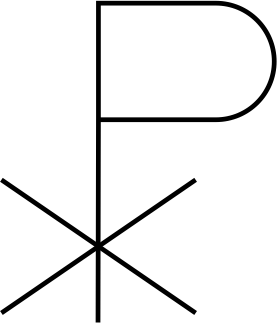
Figure 1.
For Christians this symbol stands not so much for 'arche', but rather for Christ. In that case the monogram is read as 'XP'. These letters correspond to the basic sound in 'Christ', namely 'kr'. So it is in this so called 'chi-rho' monogram that a relation occurs between 'arche' and 'Christ'.5 Arche is Christ. But who is Christ? In esoteric thought the term 'Christ' is not so much used to refer to the person Jesus of Nazareth, but more primarily to a principle: the 'Christ principle'. This principle is considered to occur when spirit relates to matter, and is held to be the same as the soul principle. As such it is the intermediating factor between the aforementioned poles (as Jesus Christ is considered to be the intermediating factor between man and God).6
So far this chi-rho symbol has been considered grammatically, but it can also be looked upon in a geometrical way. The symbol represents a sound, but in being representative it has a distinctive shape and form. Now the basic features of the symbol are a more or less oval shape on top and a cross at its base. This considering it may dawn that as a geometrical symbol it has not so much been introduced by the Greeks on base of their grammatical script signs, but that it is rather derived from the older Egyptian symbol.
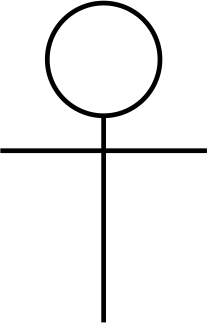
Figure 2.
For the meaning of this Egyptian 'ankh', as the symbol is called, is remarkably similar to the chi-rho symbol of the Christians. The meanings attached to the ankh symbol are namely 'life' and 'soul'.7 In these meanings can clearly Christ be recognized. After all did Jesus Christ himself proclaim to be the life.8 But the relation of Christ with the ankh goes obviously further, for all will recognize the Christian cross in the ankh. The crucifixion of the son of God on the cross brings forth the Christ, just as the entering of spirit into matter brings forth the Christ or soul principle.9 The ankh as Christ and as arche is the beginning and the origin, because it is only through the relation of spirit and matter that anything comes to being.10 Through the union of father-spirit and mother-matter, Christ (being the son and the soul) is the firstborn.11 And being the firstborn from whence everything else originates, may in this way Christ be well considered to be the origin of all things.
So in Christ, father-spirit and mother-matter are united. We see this reflected both in the Christian crucifix and the Egyptian ankh. The crucifix shows Jesus crucified to a cross. In this symbol the cross stands for matter on which Jesus, standing for spirit, is crucified.12 The ankh also consists of such a dual composition. For it is composed of a tau-cross and an ellipse placed on top (forming together a full cross). Here a more detailed explanation needs to be given. Generally cosmic evolution is esoterically symbolized as follows. First the ellipse or the circle is given, isolated from any other symbol.
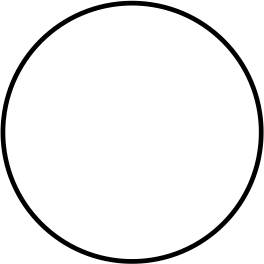
Figure 3.
This isolated circle stands for the great absolute beyond any duality. Then a point appears within the circle.
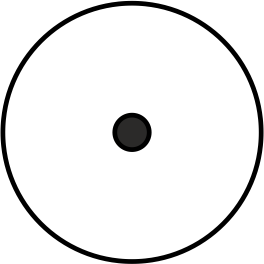
Figure 4.
This point is the father principle, and the circle has become the mother principle, carrying the father principle still in her womb. After that a horizontal line divides the circle through the middle.
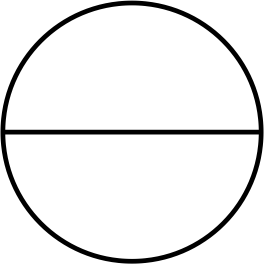
Figure 5.
The father principle has come to being, resulting in the great duality of spirit (above) and matter (below). In the next symbol the father has fecundated the mother, symbolized by a vertical line in the mother principle. The symbol now shows a tau-cross in the circle.
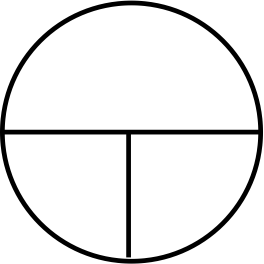
Figure 6.
Through this fecundation the Christ principle is born, symbolized as the cross in the circle.
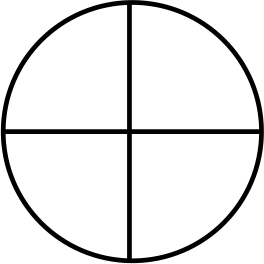
Figure 7.
In this combination the cross symbolizes the manifested universe, and the circle the primal principle beyond duality. When the cross after that is depicted above the circle, it symbolizes the crucified Christ on mount Golgatha or Calvary.
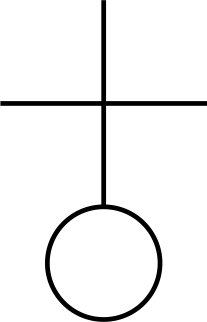
Figure 8.
In this symbol manifested creation dominates over Christ. When the cross however is depicted below the circle, then the victorious and resurrected Christ is symbolized.
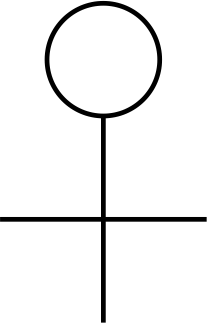
Figure 9.
And in this symbol we of course recognize the Egyptian ankh symbol.
In this sense the ankh symbol may also be thought of as the symbol for the enlightened human individual. For on the path of enlightenment the personality principle must submit itself to the soul or Christ principle. The lower self must bow for the higher self.13 And with those who have not yet reached such a submission, and this goes for the majority of human beings living on Earth, does the self-centered personality still dominate the soul principle.
Now the last two given symbols are also to be recognized as the astrological symbols of the planets Earth and Venus. This may indeed lead to the consideration of Earth as a sphere where the Christ principle is brought to death through crucifixion on manifested creation, and of Venus as a sphere where the Christ principle is victorious over manifested creation. These considerations are analogous to the aspects of man, when he is considered to consists of a lower self and a higher self, or of a body and a soul. Earth then is the planet that resembles symbolically and houses actually those men who have not yet subjugated their lower self to their Christ principle within, and Venus then is the planet that resembles symbolically and houses actually those men in whom their Christ principle triumphed. Esoterically this makes sense, for in esoteric thought Venus is indeed considered to be to Earth what the higher self or the soul is to the lower self or personality.14
Arc
At the beginning of the previous paragraph it was written that in contemplating 'arch' the emphasis would be laid on 'arch' as a prefix and as a noun. As a prefix it has thus been contemplated, and now we shall continue with 'arch' as a noun. That this is done under the title of 'arc' is because the noun 'arch' and the noun 'arc' are very similar in meaning, and because both are given similar etymological roots. 'Arch' refers to a (constructed) bow or a curve,15 and 'arc' refers to a part of a curve or circle.16 Both are considered to be derived from the Latin 'arcus',17 which also carries meanings pertaining to (constructed) curves and bows.18
So how do we get from the considerations of the previous paragraph to the nouns 'arch' and 'arc' denoting a curve or a bow? The first step to bridge this apparent gap is to bring the Sun under the attention as one of the great symbols of the Christ principle.19 It may very well be beyond coincidence that Pythagoras called Venus 'the other Sun'.20 To connect 'arch' and 'arc' to the sun might become plausible when we search etymologically beyond the Latin 'arcus' and even beyond the Greek language. English, Latin and Greek all belong to the family of proto-Indo-European languages. This is a family of languages to which also the ancient language Sanskrit belongs,21 which is often considered to antedate even ancient Greek. Thus it may be rewarding to involve Sanskrit as well in our etymological analysis's.22 Now in relation to the present contemplation do three words with similar soundings occur in Sanskrit, namely 'ark', 'arka' and 'arc'. 'Ark' means 'to heat' and 'to praise',23 'arka' refers to a ray, a flash of lightning, the Hindu god Indra or to the Sun,24 and 'arc' carries meanings such as 'to shine', 'to praise' and 'to worship'.25 Taking notice of this, it should be clear that in these meanings the Sun is the pivotal factor. The Sun is hot, shiny and is worthy of praise and worship. That the Sun is worthy of worship is an understandable statement since throughout most cultures the Sun has been worshiped as a life giving god.26
So how then is the Sun related to a bow or a curve? A first indication can be found in the given that the Sun is worshiped in many cultures. For in worship do people bow to their gods. In worship the human body is bent in the shape of an arc(h). Now in this worship, the path which the Sun follows is during the day (and night) often given a central role. The Greek Helios for instance rode his four-horsed Sun chariot across the sky from east to west.27 A picture very similar to that of the Hindu Sun god Sūrya, who also rides a four (or seven) horsed chariot.28 And also the Egyptian Sun god Ra followed the same course, be it in his case in a Sun boat.29 Now from the perspective of the human onlooker on earth does the Sun follow its course in the form of an arc(h). It rises at the eastern horizon, follows a bow over the onlooker's head, and sets at the western horizon. The Sun draws a clear arc(h) in the sky. Not for nothing does the English noun 'arc' also refer to the course of heavenly bodies in relation to the horizon.30
Now let us continue from the earlier found ankh symbol. This Christ symbol is not the ultimate root symbol, for the ankh was preceded by the symbol of a loop.31
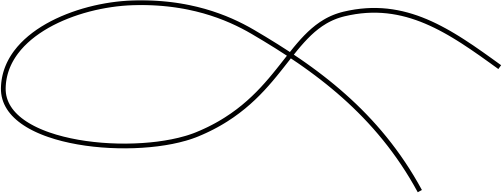
Figure 10.
In this symbol we recognize again the ellipse and the cross. Here the ellipse stands for the place in the north from which the Sun is born.32 It is in this quarter that the constellation of the Great Bear or Ursa Major is found, and the ellipse of the loop is esoterically considered to symbolize the circle that the Great Bear makes.33 So the Sun is born from the ellipse which the Great Bear makes. This is a remarkable statement that may become more plausible when a relation between the Great Bear and the Sun, and also Christ, can be sketched. Now the Great Bear, consisting of seven stars, is esoterically considered to be the origin of the seven rays that determine all quality in our solar system, and thus also on our planet.34 In this sense the influence of the Great Bear is Christ bearing, for it is from the Christ principle that all else evolves, as we have seen in the previous paragraph. All that has being is qualified being, all that is, originates from Christ, and all qualities originate from the Great Bear. Thus we may recognize in the Great Bear a Christ of grand splendor. It is not for nothing that (with Christ being the son principle) the occult Path of Absolute Sonship involves the Great Bear, the Sun and the seven sacred (victorious Christ) planets,35 of which Venus is one.36 Taking further in account that one of the stars of the Great Bear is esoterically considered to be to the Sun what the higher self is to the lower self,37 the deep fetching relation between the Great Bear, the Sun and Christ may be realized. This notion is here of importance because the term 'arc' appears also in the word 'arctic', which refers to the North Pole, which in turn is placed in the quarter where also the Great Bear makes its loop in the sky. It is therefore also that 'arctic' is considered to be derived from the Greek 'arktos'.38 For 'arktos' means 'bear' in general, but it refers in particular also to the constellation or the Great Bear.39 Thus the relations between 'arc' (as in 'arctic' and as noun), the Great Bear, the Sun and Christ have been explicated.
Ark
Generally the English word 'ark' is given different etymological roots than the terms of the previous paragraph (though probably not rightfully as we shall see). The word is used mainly to refer to a chest or a box, or to a ship or boat.40 Etymologically the word is considered to be rooted in the Latin 'arca',41 which refers also to a box or a chest, especially for storing valuables (although it may also refer to a coffin or a prison cell).42 So the thoughts which 'ark' expresses are those of a container or a covering. From the same root comes also the English word 'arcane',43 meaning 'hidden', 'concealed' and 'secret'.44 So basically an ark may be considered to be a box or chest in which a valuable secret is contained, hidden and concealed.
Now it is hard to use the word 'ark' without thinking of the ark of the covenant and the ark of Noah. In 'Exodus' in The Old Testament does God order Moses to build an ark.45 A quite exact description is given of how this ark should be formed. The most eye catching features of this ark are its chest-like form, and the two cherubim on top who are facing each other and touching each other high with the top of their wings (by which they are covering that which is translated as the 'mercy-seat'). In this ark the in stone inscribed ten commandments are contained, and this makes it known as 'the ark of the covenant' (referring to the covenant of God with the people of Israel).46 Obviously this ark answers to the particularities that have been mentioned in the etymological consideration of 'ark'. The ark of the covenant is a box or chest in which a valuable secret is contained, hidden and concealed.
Now the shape of the ark is of interest for this contemplation. The base consists of a rectangular box. And when this box is laid out into a two-dimensional symbol, then the tau-cross or the Christian cross appears.
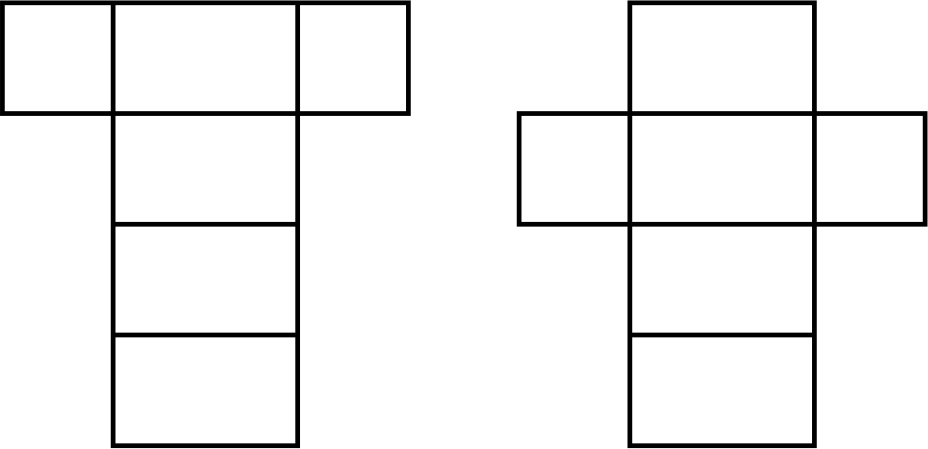
Figure 11.
And on top of this ark did God order Moses to put two cherubim, facing each other and touching each other high with the top of their wings. In this way then the two cherubim are forming an ellipse.
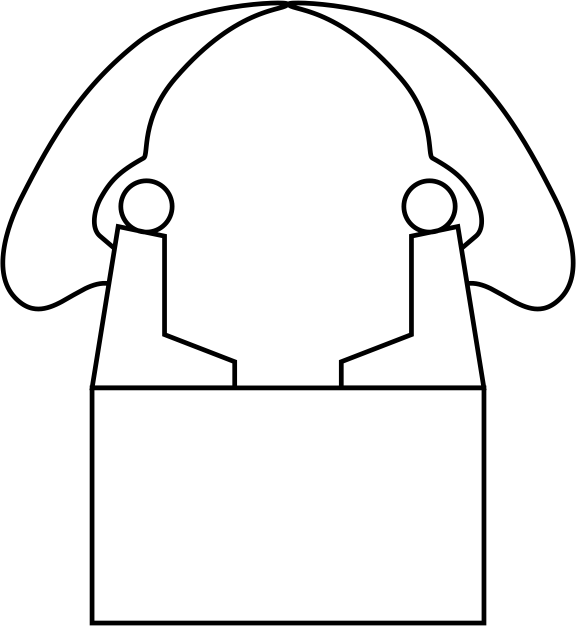
Figure 12.
Thus we see in the ark of the covenant, with the ellipse on top of the cross, again the ankh sign and the symbol of the victorious Christ.
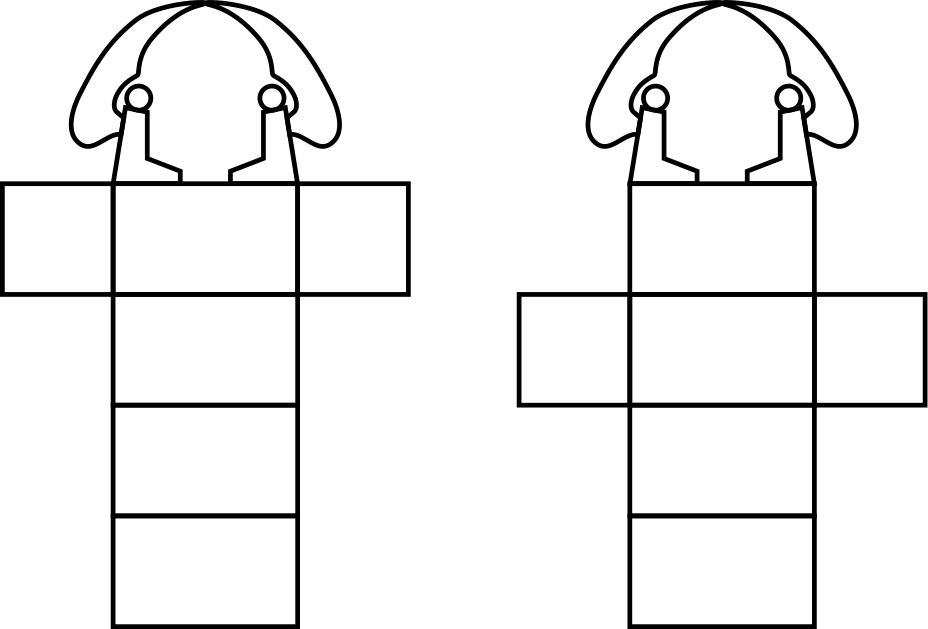
Figure 13.
It is then no wonder that God says that he will meet and commune with Moses from the inside of this ellipse (above the mercy-seat and between the two cherubim).47 For only through Christ does man come to God,48 and Christ is born from the fecundated yoni, ellipse or circle, as we have seen earlier. That the covenant of God with the people of Israel is contained, hidden and concealed in the ark is another confirmation of this thought. Because Christ, the soul principle, is contained in the created universe. However when Christ has not become victorious yet, then he is hidden and concealed in creation. Only when victorious is Christ revealed and does God speak to man through Christ (remember that the Christ principle is applied both on an anthropological and cosmological scale).
So what about the ark of Noah? This was considered the other biblical ark to which thoughts are automatically directed with the use of the word 'ark'. The story of Noah's ark appears in The Old Testament in 'Genisis'.49 In that story does God command Noah to build an ark, a boat, to house his family and also male and female specimens of every living being.50 This with the goal to repopulate the earth after God would have sent his flood over it.51
Now where in the previous biblical story the ark was a chest or box, there the ark in this story is a ship or a boat. And the particular shape of a boat is again elliptical.
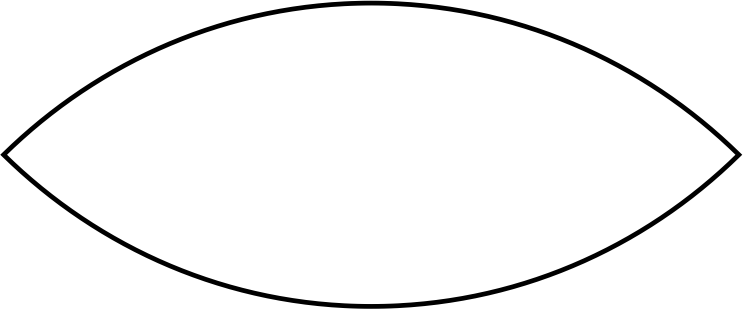
Figure 14.
And in this elliptical boat and ark are contained all the living beings that shall populate the earth when the waters have lowered. Being acquainted now with esoteric interpretations of the ellipse, the symbolism shall be clear. The ark of Noah, containing all the life forms, is the fecundated yoni that gives birth to the Christ principle.52 As we have seen did Christ state to be the life.53 But this life does not leave Noah's ark before the waters have dried up. And similarly does Christ not find birth before the lower self has sunk away and all its desires have dried up.
Indeed is the figure of the ark as a boat reminiscent of an eye also. Now Christ said that no one comes to the Father but by him.54 So the Christ principle is the mediating principle. And as the higher self he is the mediating principle between the lower self and the spiritual self, or to put it more simple: between the non-self and the self. And similarly the eye as the most important sense in man is also the medium between what man is not (the seen objects) and what he is (the seer). Thus the analogy between the eye and Christ holds. Interestingly to remark here is that the Hindi word for 'eye' is 'āṁkh',55 which might very well be etymologically related to 'ankh'. To deepen this possible relation out however another contemplation would be needed. For indeed would it be interesting to contemplate the symbolism of the eye somewhat deeper, also in relation to Gods all seeing eye, the eye of Shiva and the third eye. However there is no space here to do this. Thus it shall be left to be contemplated somewhere else.
Now we recognized in the shape of the ark of Noah an ellipse and an eye. But there is still another symbol that can be recognized in that shape, namely the Christian symbol of the fish.
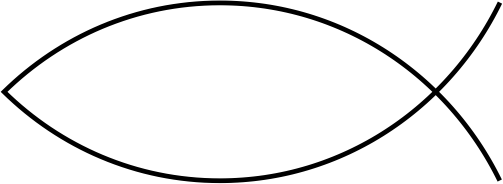
Figure 15.
The meanings that can be attached to this symbol stretch themselves from the prophet Jesus Christ to Christ universally. Christ taken in a universal way (and 'universal' here is meant to denote a generality and not a cosmicality) is to be recognized again in the ellipse and the cross, which are both present in the Christian fish symbol. It also comes very close to the loop that anteceded the ankh symbol. But at the same time does the fish refer to Jesus Christ. Jesus Christ was the prophet of the astrological age of Pisces (also known as the 'fishes' sign).56 As such his closest disciples were fishers, whom he made fishers of men.57 He also worked wonders with fishes. He multiplied them to feed a crowd,58 and he ordered Simon to catch a fish with a coin in its mouth.59 And it is also by eating fish that the disciples broke their fast on Jesus Christ's appeal.60 Further, after his resurrection he also ate fish while informing his disciples about his destiny and the disciples' mission.61
Conclusion
In this contemplation we set out to dig deeper than general accepted etymology into the roots of the English terms 'arch', 'arc' and 'ark'. For this esoteric thought would be applied.
A start was made with 'arch', which was commonly accepted to be rooted in 'arche'. Through the chi-rho monogram we were able to relate 'arche' to Christ, which was primarily considered to be a principle. This chi-rho monogram found its root in the Egyptian ankh symbol, for both these symbols consist of an ellipse placed on a cross. Through this view the astrological symbols for Venus and Earth also came in view. Venus as the resurrected and victorious Christ and the ankh symbol representing life and soul bring, through the chi-rho cross, with a further clarity 'arch' in relation to Christ.
'Arch' and 'arc' as a bow or a curve were etymologically brought back to the Latin 'arcus', which refers to the same as its English offsprings. We dug etymologically deeper and found in the Sanskrit terms 'ark', 'arka' and 'arc' the Sun to be a pivotal factor. It was contemplated that 'arch' and 'arc', when denoting a bow or curve, relate to the curve which the Sun during the day seems to make for the ancient onlooker. 'Arc' as it occurs in 'arctic' was through the Greek 'arktos' related to the Great Bear. This constellation of the northern quarter was symbolized by the loop, from which ellipse the Sun was considered to find birth. With thematizing the Great Bear and the Sun as exponents of the Christ principle on a grander scale, 'arc', both in carrying the meaning of 'curve' and as occurring in 'arctic', was related again to Christ.
'Ark' was considered commonly to be rooted in the Latin 'arca', referring to a box or chest (in which a valuable secret is contained, hidden and concealed if the English 'arcane' is taken in consideration also). However since 'ark' can hardly be thought of without thinking of the ark of the covenant and the ark of Noah these two biblical stories were considered. In thematizing the shape of the ark of the covenant it was found that when it was laid out in a two dimensional symbol again the ellipse on the cross appeared, thus relating it to Christ. Noah's ark was thematized in its boat-like shape, and the ellipse was again recognized. Containing the seeds of life also this ark was given a relation to the Christ principle. This boat-like shape was also reminiscent of the Christian fish symbol, which was shown to have deep connections to Jesus Christ.
And thus it may be concluded that 'arch', 'arc' and 'ark' find a common root in thoughts related to Christ.
Notes
- Oxford English Dictionary, Second Edition on CD-ROM (v. 4.0), Oxford University Press, 2009.
- Ibidem, arch-, prefix.
- Henry George Liddell / Robert Scott, A Greek-English Lexicon, Oxford University Press, Oxford, 1996, p. 252.
- Ibidem.
- Helena P. Blavatsky, The Secret Doctrine, Volume II, in: Theosophical Classics, (CD-ROM), Theosophical Publishing House, Manilla, 2002, p. 547.
-
Alice A. Bailey, A Treatise on White Magic, in: Twenty-Four Books of Esoteric Philosophy, (CD-ROM), Lucis Trust, London / New York, 2001, p. 35. "a. The soul therefore is neither spirit nor matter but is the relation between them.
b. The soul is the mediator between this duality; it is the middle principle, the link between God and His form.
c. Therefore the soul is another name for the Christ principle, whether in nature or in man." - Oxford English Dictionary.
- The American Standard New Testament, (software), Version 1.0, Ages Software, Albany, 1996, John, Ch. 14, v. 6. "Jesus saith unto him, I am the way, and the truth, and the life: no one cometh unto the Father, but by me."
- Alice A. Bailey, From Bethlehem to Calvary, in: Twenty-Four Books of Esoteric Philosophy, (CD-ROM), Lucis Trust, London / New York, 2001, p. 181. "The Crucifixion and the Cross of Christ are as old as humanity itself. Both are symbols of the eternal sacrifice of God as He immerses Himself in the form aspect of nature and thus becomes God immanent as well as God transcendent."
- 'Contemplations, Sex; Human Reproduction, Mystic Enlightenment and Cosmic Creation', Index: 201003081.
- Alice A. Bailey, Esoteric Psychology, Volume I, A Treatise on the Seven Rays, Volume I, in: Twenty-Four Books of Esoteric Philosophy, (CD-ROM), Lucis Trust, London / New York, 2001, p. 291. "Father-spirit and mother-matter unite and are at-one and the Christ is born."
- Nota 9.
- From Bethlehem to Calvary, p. 194. "He [Christ] died the death of the Cross to show us (in picture form and through actual demonstration) that divinity can be manifested and can truly express itself only when man, as man, has died in order that the hidden Christ may live. The lower carnal nature (as St. Paul loved to call it) must die in order that the higher divine nature may show forth in all its beauty. The lower self must die in order that the higher self can manifest on earth."
- Alice A. Bailey, A Treatise on Cosmic Fire, in: Twenty-Four Books of Esoteric Philosophy, (CD-ROM), Lucis Trust, London / New York, 2001, p. 298. "Perhaps some idea may be gained if we remember that, in an occult sense, Venus is to the Earth what the higher Self is to man."
- Oxford English Dictionary, arch, n..
- Oxford English Dictionary, arc, n..
- John Ayto, Word Origins, The Hidden Histories of English Words from A to Z, A & C Black, London, 2005, p. 32.
- Oxford Latin Dictionary, Oxford University Press, London, 1968, p. 164.
- Alice A. Bailey, Esoteric Astrology, A Treatise on the Seven Rays, Volume III, in: Twenty-Four Books of Esoteric Philosophy, (CD-ROM), Lucis Trust, London / New York, 2001, p. 100. "The Sun is the symbol of the Son of God, Who is the mediator between Father-Spirit and Mother-Matter."
- The Secret Doctrine, Volume II, p. 31. "Pythagoras calls Sukra-Venus the Sol alter, "the other Sun.""
- J. P. Mallory and D. Q. Adams, The Oxford Introduction to Proto-Indo-European and the Proto-Indo-European World, Oxford University Press, Oxford / New York / et alibi, 2006, p. xxiii.
- Monier Williams, A Sanskrit-English Dictionary, Etymologically and Philologically Arranged, With Special Reference to Greek, Latin, Gothic, German, Anglo-Saxon, and Other Cognate Indo-European Languages, The Clarendon Press, Oxford, 1862, p. v. "It [Sanskrit] is a better guide than either Greek or Latin to the structure, historical connection, and correlation of the whole Indo-European family. It is a more trustworthy authority in the solution of recondite philological problems."
- Ibidem, p. 82.
- Ibidem.
- Ibidem, p. 83.
- UXL Encyclopedia of World Mythology, Volumes 1-5, (e-book), Gale, Cengage Learning, Detroit / et alibi, 2009, p. 966.
- Jenny March, Cassell's Dictionary of Classical Mythology, Cassell & Co, London, 1998, p. 366.
- Manfred Lurker, The Routledge Dictionary of Gods and Goddesses, Devils and Demons, Routledge, London / New York, 2004, p. 178.
- UXL Encyclopedia of World Mythology, p. 873, 966.
- Oxford English Dictionary, arc, n., 2.
- The Secret Doctrine, Volume II, p. 547.
- Sir J. Y. Simpson, in: Ibidem. "This denotes the birth-place in the northern quarter of the heavens, from which the Sun is reborn."
- Ibidem. "This then represents the circle made in the northern heaven by the Great Bear, […]."
- Esoteric Astrology, p. 589. "Seven stars of the Great Bear are the originating Sources of the seven rays of our solar system. The seven Rishis (as They are called) of the Great Bear express Themselves through the medium of the seven planetary Logoi Who are Their Representatives and to Whom They stand in the relation of cosmic Prototype. The seven Planetary Spirits manifest through the medium of the seven sacred planets."
- Alice A. Bailey, The Rays and the Initiations, A Treatise on the Seven Rays, Volume V, in: Twenty-Four Books of Esoteric Philosophy, (CD-ROM), Lucis Trust, London / New York, 2001, p. 422-423. "You have, therefore, the following triangle composed of one stream of energy emanating from the Great Bear, another stream of energy issuing from the Heart of the Sun or from our Solar Logos, and the base line constituted of the seven streams of energy which come from our seven sacred planets."
- A Treatise on Cosmic Fire, p. 298. "In connection with these two planets, it must be remembered that Venus is a sacred planet and the Earth is not."
- Alice A. Bailey, Initiation, Human and Solar, in: Twenty-Four Books of Esoteric Philosophy, (CD-ROM), Lucis Trust, London / New York, 2001, p. 98. "It emanates from that one of the seven stars of the Great Bear whose ensouling life holds the same relationship to our Planetary Logos as the Ego does to a human being."
- Oxford English Dictionary, Arctic, a. and n..
- A Greek-English Lexicon, Oxford University Press, p. 242.
- Oxford English Dictionary.
- Word Origins, p. 34.
- Oxford Latin Dictionary, p. 161.
- Word Origins, p. 32.
- Oxford English Dictionary.
- The American Standard Old Testament, (software), Version 1.0, Ages Software, Albany, 1996, Exodus, Ch. 25.
- Ibidem, 1 Kings, Ch. 8, v. 9. "There was nothing in the ark save the two tables of stone which Moses put there at Horeb, when Jehovah made a covenant with the children of Israel, when they came out of the land of Egypt."
- Ibidem, Exodus, Ch. 25, v. 22. "And there I will meet with thee, and I will commune with thee from above the mercy-seat, from between the two cherubim which are upon the ark of the testimony, of all things which I will give thee in commandment unto the children of Israel."
- Nota 8.
- The American Standard Old Testament, Genesis, Ch. 6-9.
- Ibidem, Ch. 6, v. 18, 19. "But I will establish my covenant with thee; and thou shalt come into the ark, thou, and thy sons, and thy wife, and thy sons' wives with thee. And of every living thing of all flesh, two of every sort shalt thou bring into the ark, to keep them alive with thee; they shall be male and female."
- Ibidem, Ch. 7, v. 3. "[…], to keep seed alive upon the face of all the earth."
- Parkhurst, in: The Secret Doctrine, Volume II, p. 313. "Aρχὴ (ark) answers to the Hebrew rasit, or Wisdom . . . . and (at the same time) to the emblem of the female generative power, the Arg or Arca, in which the germ of nature (and of mankind) floats or broods on the great Abyss of the waters, during the interval which takes place after every mundane (or racial) cycle."
- Nota 8.
- Ibidem.
- S. K. Verma and R. N. Sahai (editors), Oxford English-Hindi Dictionary, Oxford University Press, Oxford / New York / et alibi, 2008, p. 266.
- From Bethlehem to Calvary, p. 18-19. "He [Christ] came at the beginning of that astronomical age which we call "the Piscean age" because, during this period of approximately two thousand years, our sun is passing through that sign in the zodiac which we call Pisces, or the Fishes. Hence the frequent references to fishes, and the appearance of the symbol of the fish in Christian literature, including the New Testament."
- The American Standard Old Testament, Mathew, Ch. 4, v. 18-22. "And walking by the sea of Galilee, he saw two brethren, Simon who is called Peter, and Andrew his brother, casting a net into the sea; for they were fishers. And he saith unto them, Come ye after me, and I will make you fishers of men. And they straightway left the nets, and followed him. And going on from thence he saw two other brethren, James the son of Zebedee, and John his brother, in the boat with Zebedee their father, mending their nets; and he called them. And they straightway left the boat and their father, and followed him."
- Ibidem, Ch. 15, v. 34-37. "And Jesus said unto them, How many loaves have ye? And they said, Seven, and a few small fishes. And he commanded the multitude to sit down on the ground; and he took the seven loaves and the fishes; and he gave thanks and brake, and gave to the disciples, and the disciples to the multitudes. And they all ate, and were filled: and they took up that which remained over of the broken pieces, seven baskets full."
- Ibidem, Ch. 17, v. 27. "But, lest we cause them to stumble, go thou to the sea, and cast a hook, and take up the fish that first cometh up; and when thou hast opened his mouth, thou shalt find a shekel: that take, and give unto them for me and thee."
- Ibidem, John, Ch. 21, v. 10-12. "Jesus saith unto them, Bring of the fish which ye have now taken. Simon Peter therefore went up, and drew the net to land, full of great fishes, a hundred and fifty and three: and for all there were so many, the net was not rent. Jesus saith unto them, Come and break your fast."
- Ibidem, Luke, Ch. 24, v. 42, 43. "And they gave him a piece of a broiled fish. And he took it, and ate before them."
Bibliography
- 'Contemplations, Sex; Human Reproduction, Mystic Enlightenment and Cosmic Creation', Index: 201003081.
- John Ayto, Word Origins, The Hidden Histories of English Words from A to Z, A & C Black, London, 2005.
- Helena P. Blavatsky, The Secret Doctrine, Volume II, in: Theosophical Classics, (CD-ROM), Theosophical Publishing House, Manilla, 2002.
- Alice A. Bailey, A Treatise on Cosmic Fire, in: Twenty-Four Books of Esoteric Philosophy, (CD-ROM), Lucis Trust, London / New York, 2001.
- Alice A. Bailey, A Treatise on White Magic, in: Twenty-Four Books of Esoteric Philosophy, (CD-ROM), Lucis Trust, London / New York, 2001.
- Alice A. Bailey, Esoteric Astrology, A Treatise on the Seven Rays, Volume III, in: Twenty-Four Books of Esoteric Philosophy, (CD-ROM), Lucis Trust, London / New York, 2001.
- Alice A. Bailey, Esoteric Psychology, Volume I, A Treatise on the Seven Rays, Volume I, in: Twenty-Four Books of Esoteric Philosophy, (CD-ROM), Lucis Trust, London / New York, 2001.
- Alice A. Bailey, From Bethlehem to Calvary, in: Twenty-Four Books of Esoteric Philosophy, (CD-ROM), Lucis Trust, London / New York, 2001.
- Alice A. Bailey, Initiation, Human and Solar, in: Twenty-Four Books of Esoteric Philosophy, (CD-ROM), Lucis Trust, London / New York, 2001.
- Alice A. Bailey, The Rays and the Initiations, A Treatise on the Seven Rays, Volume V, in: Twenty-Four Books of Esoteric Philosophy, (CD-ROM), Lucis Trust, London / New York, 2001.
- Henry George Liddell / Robert Scott, A Greek-English Lexicon, Oxford University Press, Oxford, 1996.
- Manfred Lurker, The Routledge Dictionary of Gods and Goddesses, Devils and Demons, Routledge, London / New York, 2004.
- J. P. Mallory and D. Q. Adams, The Oxford Introduction to Proto-Indo-European and the Proto-Indo-European World, Oxford University Press, Oxford / New York / et alibi, 2006.
- Jenny March, Cassell's Dictionary of Classical Mythology, Cassell & Co, London, 1998.
- S. K. Verma and R. N. Sahai (editors), Oxford English-Hindi Dictionary, Oxford University Press, Oxford / New York / et alibi, 2008.
- Monier Williams, A Sanskrit-English Dictionary, Etymologically and Philologically Arranged, With Special Reference to Greek, Latin, Gothic, German, Anglo-Saxon, and Other Cognate Indo-European Languages, The Clarendon Press, Oxford, 1862.
- Oxford English Dictionary, Second Edition on CD-ROM (v. 4.0), Oxford University Press, 2009.
- Oxford Latin Dictionary, Oxford University Press, London, 1968.
- The American Standard New Testament, (software), Version 1.0, Ages Software, Albany, 1996.
- The American Standard Old Testament, (software), Version 1.0, Ages Software, Albany, 1996.
- UXL Encyclopedia of World Mythology, Volumes 1-5, (e-book), Gale, Cengage Learning, Detroit / et alibi, 2009.